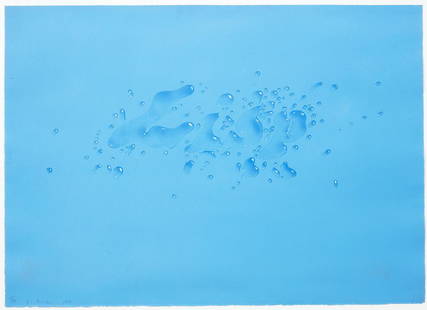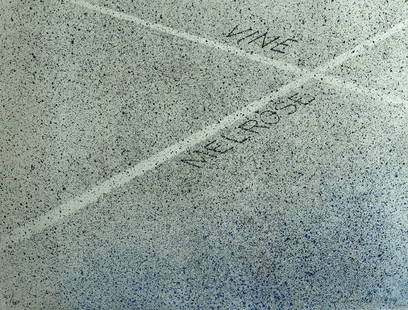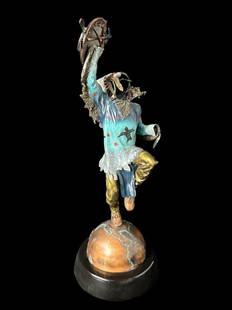
ED RUSCHA, Anchor Stuck in Sand, 1990
Similar Sale History
View More Items in ArtRelated Art
More Items in Art
View More


Item Details
Description
Anchor Stuck in Sand, 1990. acrylic on canvas 60 1/4 x 112 1/4 in. (153 x 285.1 cm) Signed and dated “Ed Ruscha, 1990” on the reverse. Also signed, titled, and dated “Ed Ruscha, Anchor Stuck in Sand, 1990” on the stretcher.
PROVENANCE James Corcoran Gallery, Santa Monica The Robert A. Rowan Collection, Los Angeles Sale: Sotheby’s, New York, Contemporary Art Part II, November 15, 2000, lot 275 Acquired at the above sale by the present owner
EXHIBITED Los Angeles, Museum of Contemporary Art (MoCA), Ed Ruscha, December 9, 1990 – February 24, 1991 Pasadena, Art Center, College of Design, Selections from the Robert A. Rowan Trust Collection, May 21 – July 9, 1995
LITERATURE R. Dean and L. Turvey, Edward Ruscha: Catalogue Raisonné of The Paintings, Volume Four: 1988-1992, New York, Gagosian Gallery, 2009, no. P1990.44, pp. 308-309 (illustrated)
My subjects tend to be recognizable objects made up of stuff that is non-objective and abstract. I have always operated on a kind of waste-andretrieval method. I retrieve and renew things that have been forgotten or wasted. ED RUSCHA (Ed Ruscha, 1986, excerpted from M. Bochner, “Ed Un-Edited”, Ed Ruscha: Catalogue Raisonne of the Paintings, Edited by Robert Dean and Lisa Turvey, Gottingen, 2009, p. 16). Ed Ruscha’s presence as a mainstay of American contemporary art in the past five decades has cemented his place as a quintessential voice of America’s vast visual influence. In producing an oeuvre as prolific as it is profound, Ruscha’s work has ranged from his portraits of Los Angeles culture to his breathtaking paintings of the American landscape. And, of course, it goes without saying that he has done more for the intrinsic beauty of the English language than the greater part of history’s visual artists; his word and letter paintings are portrayed in myriad tones and styles, against backdrops both simple and stunningly complex. Yet, as a artist unsatisfied with the over repetition of subject, Ruscha has, on occasion, dived into the depths of pictorial language alone, playing with both dramatic and cinematic qualities, as we see in the present lot, Anchor Stuck in Sand, 1990. Ruscha himself has testified to the nature of his early influences, in particular the black and white Abstract Expressionist paintings of Franz Kline. Though his early Expressionist influence began to become more obscured as he approached his mature style in the mid-1960’s, Ruscha resurrects the chromatic scheme of one of his earliest influences in the present lot. Ruscha’s technique also departs from his more familiar style of employing the conventional brushstroke to achieve the result of his canvases. He began, in the early 1980’s, to use an airbrush as commercial technique. Giving a blurred impression of an object or landscape without the definitions of lines or edges, Ruscha’s airbrush attains a reality similar to Richter’s blurring technique—an intentional distancing of the observer and the observed, where a relationship must grow rather than simply be. In addition—and in terms of its subjective content—the present lot is a counterpoint to many of Ruscha’s contemporaneous works. Previously to the late 1980s, Ruscha had concerned himself with the pictorial nature of the written letter and its obvious progression, the word. Yet here, the pendulum swings in the other direction, and we see Ruscha working in a more abstracted context, one where groundbreaking technique can be married with pith of subject in order to achieve a unique piece of art; one where nostalgia, sadness, and somber beauty intersect with the utmost visual eloquence: “The silhouette paintings that Ruscha began to paint in the mid-eighties dramatize the mechanics of viewing as a mixture of prototypical processes and archetypal images.” (B. Fer, “Moth-man: Ruscha’s Light and Dark”, Ed Ruscha: Catalogue Raisonne of the Paintings, Edited by Robert Dean and Lisa Turvey, Gottingen, 2009, p. 7). Ruscha’s chosen image in the present lot is a partially obscured ship anchor, sunken into the cold recesses of an ocean shoreline. Ruscha gives us no hints of the ship that was once tethered to the anchor’s position, yet the image retains a power so great that we need not search for any further narrative. At the upper-right corner of the picture, Ruscha airbrushes the solemn hues of an impending dawn, gradually fading to twilight on the painting’s left hand side. Condemned to a landlocked fate, Ruscha fades the body of the figure into the melancholy atmosphere, leading to the cold dunes. Though we need not form a backstory to understand the buried anchor, Ruscha’s ingenious rendering brings us to sympathize with our submerged protagonist. His image—through its instantly recognizable profile due to our own precious visual clichés of maritime films and photography, holds the power of cinema in a single frame. His blur simulates the imperfect nature of the early motion picture camera, and, consequently, Ruscha conjures countless associations with the dawn of the captured image. The present lot is a testament to Ruscha’s fantastic ability to explore the fine lines between genres and translate them into art: “Again the artist had found an approach that barely avoids being illustrative, that finds a space between representation, abstraction, and design.” (K. Brougher, “Words as Landscape”, Ed Ruscha, New York, 2000, p. 172). He fuses the notion of artistic nostalgia with a sense of magic, where we cannot differentiate what is real and what is out of focus. Anchor Stuck in Sand, 1990, is more than a somber portrait of a displaced object. It is the image-based retelling of a tragic figure, one wasting away in uselessness on a bank at dawn. Our associations are striking and immediate: “Light and shadow, which would traditionally have been rendered in painting’s most refined techniques to describe three-dimensional forms on a two dimensional plane…now tend to flatten things out. They create a fairly shallow sliver of space, in which shadows seem to play across a screen rather than open onto a fictional space beyond, or behind, the picture.”(B. Fer, “Mothman: Ruscha’s Light and Dark”, Ed Ruscha: Catalogue Raisonne of the Paintings, Edited by Robert Dean and Lisa Turvey, Gottingen, 2009, p. 7). Ruscha’s combination of technique and subject makes a powerful image a heartbreaking one. What we ultimately gain from Ruscha’s painting is a canvas rich with moving metaphor, a study in pathos of the most poignant kind. Ruscha’s anchor may be buried beneath the sands of time, but his sail is free to navigate ever-more magnificent realms of expression.
PROVENANCE James Corcoran Gallery, Santa Monica The Robert A. Rowan Collection, Los Angeles Sale: Sotheby’s, New York, Contemporary Art Part II, November 15, 2000, lot 275 Acquired at the above sale by the present owner
EXHIBITED Los Angeles, Museum of Contemporary Art (MoCA), Ed Ruscha, December 9, 1990 – February 24, 1991 Pasadena, Art Center, College of Design, Selections from the Robert A. Rowan Trust Collection, May 21 – July 9, 1995
LITERATURE R. Dean and L. Turvey, Edward Ruscha: Catalogue Raisonné of The Paintings, Volume Four: 1988-1992, New York, Gagosian Gallery, 2009, no. P1990.44, pp. 308-309 (illustrated)
My subjects tend to be recognizable objects made up of stuff that is non-objective and abstract. I have always operated on a kind of waste-andretrieval method. I retrieve and renew things that have been forgotten or wasted. ED RUSCHA (Ed Ruscha, 1986, excerpted from M. Bochner, “Ed Un-Edited”, Ed Ruscha: Catalogue Raisonne of the Paintings, Edited by Robert Dean and Lisa Turvey, Gottingen, 2009, p. 16). Ed Ruscha’s presence as a mainstay of American contemporary art in the past five decades has cemented his place as a quintessential voice of America’s vast visual influence. In producing an oeuvre as prolific as it is profound, Ruscha’s work has ranged from his portraits of Los Angeles culture to his breathtaking paintings of the American landscape. And, of course, it goes without saying that he has done more for the intrinsic beauty of the English language than the greater part of history’s visual artists; his word and letter paintings are portrayed in myriad tones and styles, against backdrops both simple and stunningly complex. Yet, as a artist unsatisfied with the over repetition of subject, Ruscha has, on occasion, dived into the depths of pictorial language alone, playing with both dramatic and cinematic qualities, as we see in the present lot, Anchor Stuck in Sand, 1990. Ruscha himself has testified to the nature of his early influences, in particular the black and white Abstract Expressionist paintings of Franz Kline. Though his early Expressionist influence began to become more obscured as he approached his mature style in the mid-1960’s, Ruscha resurrects the chromatic scheme of one of his earliest influences in the present lot. Ruscha’s technique also departs from his more familiar style of employing the conventional brushstroke to achieve the result of his canvases. He began, in the early 1980’s, to use an airbrush as commercial technique. Giving a blurred impression of an object or landscape without the definitions of lines or edges, Ruscha’s airbrush attains a reality similar to Richter’s blurring technique—an intentional distancing of the observer and the observed, where a relationship must grow rather than simply be. In addition—and in terms of its subjective content—the present lot is a counterpoint to many of Ruscha’s contemporaneous works. Previously to the late 1980s, Ruscha had concerned himself with the pictorial nature of the written letter and its obvious progression, the word. Yet here, the pendulum swings in the other direction, and we see Ruscha working in a more abstracted context, one where groundbreaking technique can be married with pith of subject in order to achieve a unique piece of art; one where nostalgia, sadness, and somber beauty intersect with the utmost visual eloquence: “The silhouette paintings that Ruscha began to paint in the mid-eighties dramatize the mechanics of viewing as a mixture of prototypical processes and archetypal images.” (B. Fer, “Moth-man: Ruscha’s Light and Dark”, Ed Ruscha: Catalogue Raisonne of the Paintings, Edited by Robert Dean and Lisa Turvey, Gottingen, 2009, p. 7). Ruscha’s chosen image in the present lot is a partially obscured ship anchor, sunken into the cold recesses of an ocean shoreline. Ruscha gives us no hints of the ship that was once tethered to the anchor’s position, yet the image retains a power so great that we need not search for any further narrative. At the upper-right corner of the picture, Ruscha airbrushes the solemn hues of an impending dawn, gradually fading to twilight on the painting’s left hand side. Condemned to a landlocked fate, Ruscha fades the body of the figure into the melancholy atmosphere, leading to the cold dunes. Though we need not form a backstory to understand the buried anchor, Ruscha’s ingenious rendering brings us to sympathize with our submerged protagonist. His image—through its instantly recognizable profile due to our own precious visual clichés of maritime films and photography, holds the power of cinema in a single frame. His blur simulates the imperfect nature of the early motion picture camera, and, consequently, Ruscha conjures countless associations with the dawn of the captured image. The present lot is a testament to Ruscha’s fantastic ability to explore the fine lines between genres and translate them into art: “Again the artist had found an approach that barely avoids being illustrative, that finds a space between representation, abstraction, and design.” (K. Brougher, “Words as Landscape”, Ed Ruscha, New York, 2000, p. 172). He fuses the notion of artistic nostalgia with a sense of magic, where we cannot differentiate what is real and what is out of focus. Anchor Stuck in Sand, 1990, is more than a somber portrait of a displaced object. It is the image-based retelling of a tragic figure, one wasting away in uselessness on a bank at dawn. Our associations are striking and immediate: “Light and shadow, which would traditionally have been rendered in painting’s most refined techniques to describe three-dimensional forms on a two dimensional plane…now tend to flatten things out. They create a fairly shallow sliver of space, in which shadows seem to play across a screen rather than open onto a fictional space beyond, or behind, the picture.”(B. Fer, “Mothman: Ruscha’s Light and Dark”, Ed Ruscha: Catalogue Raisonne of the Paintings, Edited by Robert Dean and Lisa Turvey, Gottingen, 2009, p. 7). Ruscha’s combination of technique and subject makes a powerful image a heartbreaking one. What we ultimately gain from Ruscha’s painting is a canvas rich with moving metaphor, a study in pathos of the most poignant kind. Ruscha’s anchor may be buried beneath the sands of time, but his sail is free to navigate ever-more magnificent realms of expression.
Buyer's Premium
- 25% up to $50,000.00
- 20% up to $1,000,000.00
- 12% above $1,000,000.00
ED RUSCHA, Anchor Stuck in Sand, 1990
Estimate $700,000 - $900,000
1 bidder is watching this item.
Get approved to bid.
Shipping & Pickup Options
Item located in New York, NY, usSee Policy for Shipping
Payment

Related Searches
TOP





































































